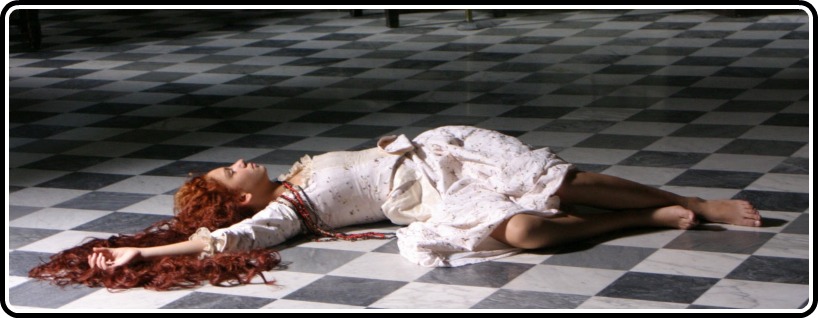There are moments in ‘Of Love and Other Demons’ where it feels as though the main character of the film is Eliza Triana’s hair, I mean that in a good way. There are at least two feet of striking red curls cascading across her shoulders and onto the mattress in her holding cell where she lies imprisoned for the majority of the film. She moves it out of the way, tucks it and hides behind it, and we can’t help but notice.
Set in colonial-period Colombia, the movie begins with young Sierva (Triana) relaxing in a hammock, gazing at a couple of pet lizards, free and content. During a subsequent trip to the marketplace she is bitten on the leg by a rabid dog on the loose and develops a fever. Being a time in history of witch hunts and inquisition, the possibility of contracting rabies is the probability of demonic possession in the eyes of many. Sierva is promptly shipped off to a monastery and roughly shackled to a bed inside a prison cell, left alone to shiver and await an exorcism.
Cayetano (Pablo Derqui), a priest in his mid-thirties is brought in to supervise her condition. After spending many days speaking with her and dressing her wounds he realizes she’s healing and quite sane. The two slowly develop romantic feelings and Cayetano wrestles with his emotions and his faith, culminating with a scene of tortured self flagellation. Tossed off of his assignment by his superior he continues to sneak into the monastery and visit Sierva in secret.
Costa Rican writer-director Hilda Hidalgo is paces the tender romantic moments slowly, giving them time to breathe. With such an large age difference between the leads, moments of desire that could have ended up salacious or creepy are quite believable. Based on the 1994 novel by Gabriel GarcÃa Márquez, This is a stylized and beautiful, but modest movie. Reminding me at times of ‘The Girl With the Pearl Earring’ from 2003, many of the shots and lighting inside the monastery setting recall the lighting of Vermeer and the saturated colors of Caravaggio.
Looking a bit more grown up than her age, 13 year-old Eliza Triana is a fantastic and charismatic young actress. With those scene-stealing locks of hair and her steady gaze it becomes hard to look away from her when she’s on the screen. The rest of the actors across the board are good, but none as memorable. Much of the movie is without score, but short pieces of mournful cello and guitar accompany Sierva’s despair and her priest’s guilt.
I assume that some of the subplots and politics of the novel were glossed over, as only toes are lightly dipped into some of the big ideas floating around. There are vague de-saturated dream sequences (the meaning of which are never quite clear) interspersed alongside scenes of the girl’s anguished father figure and sickly mother at home. Anti-church and Humanist themes are hinted at and discussed between Cayetano and his superior during lengthy discussions, but in the end the Church conquers all. The conclusion of the movie seems both abrupt and inevitable at the same time. All parties are powerless and give in to their fate without a lot of joy or victory being handed out. Regardless, I think the film will have some staying power for me. It’s just another satisfying coming of age love story set against the backdrop of religious insanity.




![Bergman Island (The Criterion Collection) [Blu-ray]](https://criterioncast.com/wp-content/uploads/2022/11/bergman-island-the-criterion-collection-blu-ray-400x496.jpg)
![This Is Not a Burial, It’s a Resurrection (The Criterion Collection) [Blu-ray]](https://criterioncast.com/wp-content/uploads/2022/11/this-is-not-a-burial-its-a-resurrection-the-criterion-collection-blu-ray-400x496.jpg)
![Lars von Trier's Europe Trilogy (The Criterion Collection) [The Element of Crime/Epidemic/Europa] [Blu-ray]](https://criterioncast.com/wp-content/uploads/2022/11/lars-von-triers-europe-trilogy-the-criterion-collection-the-element-of-400x496.jpg)
![Imitation of Life (The Criterion Collection) [Blu-ray]](https://criterioncast.com/wp-content/uploads/2022/11/imitation-of-life-the-criterion-collection-blu-ray-400x496.jpg)
![The Adventures of Baron Munchausen (The Criterion Collection) [4K UHD]](https://criterioncast.com/wp-content/uploads/2022/11/the-adventures-of-baron-munchausen-the-criterion-collection-4k-uhd-400x496.jpg)
![Cooley High [Criterion Collection] [Blu-ray] [1975]](https://criterioncast.com/wp-content/uploads/2022/11/cooley-high-criterion-collection-blu-ray-1975-400x496.jpg)